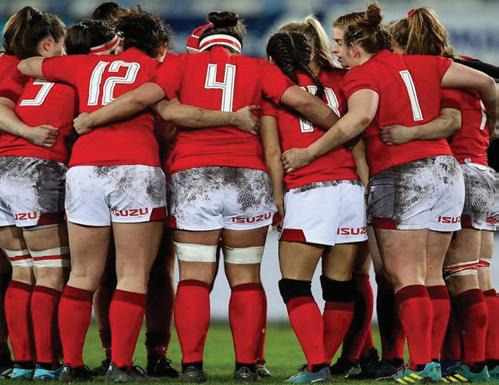
59 minute read
Gaming
@Courier_Gaming thecourieronline.co.uk/gaming the courier Monday 24 February 2020 31 culture gaming P layers of space-MMORPG EVE Online continue to be affected by a DDOS attack that has shown no sign of stopping since it began on 31 January. The US is majorly affected, but forums from Africa and Australia have reported broken servers.
For players able to log in, the servers for the popular MMO have their chat services disabled to ease the issues. However, many players continue to receive an “unable to login” screen despite multiple attempts to sign in. Gamers have reported the disconnects and lag errors with no timeframe of when it will be resolved.
Advertisement
The attack has prevented gamers from playing the game, which includes completing ‘space jobs’ and keeping control of their grounds throughout the EVE universe. Its effects on player progress become difficult to reverse in a virtual game. While many are stuck at logging on, players in unaffected areas of the world are able to use the attack as an opportunity to claim more territory.
DDOS attacks raise concerns to the gaming industry, particularly with games-as-a-service experiences like EVE Online - driven by players. Players on Reddit have demanded compensation and threatened to terminate their accounts after being unable to log in for days.
‘Lord’s Servant’, the co-leader of the ‘Forsaken Empire’ expressed on a Reddit thread the impact of the attack on small alliances within the game. He stated: “The hostiles have been able to establish themselves in a week in our region because we’ve been mostly unable to login and contest things like we normally would.”
“This is an issue that we have no control over, and no amount of ISK (in-game skill) or mechanics will allow us to do anything if we cannot log in or play the game in a reasonable state. We’ve tried everything we can in-game.” Regarding the attack, EVE Status advised players to contact their support inbox if they have lost any property during the downtime.
As of 17 February, EVE’s support tweeted: “Our Daily Downtime is taking a little longer than usual. We expect TQ to be up and accepting connections in the next couple of minutes. Thank you for your patience.” Carl Smith Valdez details the cyber-attacks on this sci-fi MMO PS5 website quietly launched DDOS destroys EVE G eorge Weidman, in my opinion, is one of the most thorough and intelligent video game journalists in the business, or at least on YouTube. With a laser-focused attention to detail, Weidman’s videos are packed with information, joyfully edited and show a level of polish that puts many others working in his industry to shame.
I first encountered BunnyHop when he was featured on TotalBiscuit’s Co-Optional Podcast. It’s a long podcast, but Weidman manages to keep things interesting alongside the late John Bain. It was here I discovered Weidman’s trilogy of videos on The Wit cher, which was an excellent analysis of both the games and the novels. Among his body of work are ludological analyses of the entire Metal Gear series, several video essays on the design of Resident Evil, and a deep look into the controversy around Hideo Kojima’s exit from Konami. You don’t see content like this every day.
What I appreciate the most about George Weidman’s content is the sheer amount of energy he brings to each project he works on. It’s clear that his content is fueled by his passion for history, game design and pulpy, postmodern narratives.
Weidman’s writing has a hyper-detailed, fanatic style that never fails to critique. It’s well-researched, consumerpositive and great watching. BunnyHop is much of what I aspire to be as a writer and critic, and you owe it to yourself to give his videos a try. W hile other YouTubers in this article may be more hands-on with their content, there are certainly other types of content creators that deserve a mention. To me, Byf immediately springs to mind.
Byf caters to a very specific part of the gaming community, dealing mainly with the lore behind Destiny 2, with a touch of Warframe, Borderlands and other assorted goodness. Although the thought of lore may, to some, be the equivalent of a sleeping pill, Byf’s passion for this niche shines through. This is perhaps most evident in some of his multiple-hour-long narrations and expositions about Destiny 2’s guardians and the stories behind them.
Even as someone who enjoys Destiny 2 for the grind and for the first-person gunplay, I still leave Byf’s videos on in the background while I play. I must admit, even though I’m no fan of lore-heavy dialogues in games, the supplemental nature of Byf’s content is likely to grow on you as it has for me.
If you’re playing a game that has a lot of mindless grinding or repetitiveness, it may be worth it to turn down the music and give Byf a go – you may just enjoy the world he weaves with his words. Beat the algorithm: the best gaming YouTubers Video games aren't just about playing. Our writers share the brightest sparks of the gaming explosion on the world's no. 1 video platform My name is Byf Shawn Khoo Super BunnyHop Alex Darbyshire
Image: IGDB
Coronavirus gets the jump on Nintendo Image: YouTube (Super Bunnyhop) Images: Twitter (@MyNameIsByf)



previously set for both the US and European markets. Moreover, despite New Horizons itself having already been delayed from its original Q4 2019 release, it will continue to be released on 20 March for the Nintendo Switch worldwide.
Unfortunately for Nintendo and Switch gamers, the disruption caused by the coronavirus does not end here. Obsidian Entertainment’s latest game, The Outer Worlds, was released on PS4, Xbox and PC on 25 October 2019 to critical acclaim and a slew of award nominations. Although the Switch port had been dated for 6 March 2020, it has now been delayed i n d e f i n it e l y. This is down to gaming studio Virtuous, which is overseeing the Switch port, having their main office in Shanghai, China.
Both the Switch console productions and delayed Outer Worlds port could hint at the further financial strains on the market due to the latest epidemic. As aforementioned, the movie industry has already been greatly affected by the loss of the Chinese market, second largest only to the United States, with many films seeing box office slumps, such as Birds of Prey and Dolittle; China has previously saved films, such as the adaptation of the eponymous Warcraft. A similar slump may indeed be seen within the gaming industry very shortly as both the production and market of China have been stricken off the record for the foreseeable future. shows that even the gaming industry is not safe from the outbreak of coronavirus

Joe Hollorankeeps his eyes open as Sony dripfeed console info S ony has quietly launched the official PlayStation 5 website, teasing the reveal of their much anticipated next-gen system. With a tentative release date set for late 2020 and few official details to go on, here's what we know so far about the PS4 successor.
Early last year Sony's Mark Cerny, the man tasked with leading the team to create both the PS4 and PS5 , confirmed that the console will retain its disk drive, but also have a feature linked to streaming as well as new storage that surpasses typical PC SSD specifications.While only a few games have been confirmed for the console thus far, expect the newest additions of Sony's biggest f r an ch i s e s , such as Horizon and The Last of Us to be on their way.
In terms of design we may know more than what’s usually the case for console reveals. Back in August, tech website LetsGoDigital released what they claimed was the patented design for the PS5. However, this turned out to be the development kit, and such pieces of equipment often bear little resemblance to the hardware that reaches customers. Nevertheless, the leaked image shows a V-shaped console (possibly a reference to the Roman numeral for five) that features multiple USB ports and extensive cooling vents, likely needed to deal with the level of power the new console will consume, and the subsequent heat that will be generated.
The Japanese media megacorp has also confirmed it will not be attending the gaming world's biggest tech and marketing event, E3 , this year. However, according to TechRadar, insiders suspect that Sony will release a slew of information about the console around the same time, on their own terms, so as to avoid competing with Microsoft for event coverage.
Fans can also take comfort in the fact that almost all PS4 games will be backward compatible for the latest console, including VR games. So players can again enjoy classics such as Shadow of the Colossus & God of War with the i mprove d specs of the new hardware. O t h e r c o n f i r m e d specs include: 3D audio, an eight core AMD chipset, SSD storage & 8K TV support capabilities. The controller will also be updated, with the DualShock 4 rumble tech being replaced instead with haptic feedback. This is all supposed to help with player immersion. The final design has yet to be confirmed by Sony but, if gaming history tells us anything, it's that the build up to the release of a new console is just as important as the console itself. Sony won the last round of the console wars, and it appears they’re gearing up to do it again. @culture_courier
@thecourieronline PS5 players can again enjoy classic games such as Shadow of the Colossus and God of War Image: Twitter (Eurogamer)
According to the DHSC the contraceptives Brevinor, Microgynon, Ovranette, Yasmin, Logynon , Qlaira, Norgeston, Femodene, Mil- linette, GedareL, Rigevidon, TriRegol, lizinna and Cilique, Evra patches, Nuvaring, Noristerat injection, Depo-Provera injection, Mirena (IUS) and Nexplanon injections still remain available to women.
Due to these shortages, it has forced women to seek alternatives or to even stop using contracep- tion entirely. Women are being sent away with prescriptions for products or the period of time there will be limited access to the products.
The Royal College of General Physicans is said to be helping women find alternatives to their usual method of contraception. As there are still various daily pills that haven’t been affected by the shortage and are easily acces- sible to use as alternatives until the issue is solved and sup- plies are back in stock. c2.science@ncl.ac.uk Science Editors Eleanor Gratton, Patrick Harland & Seshadhri Subramanian the courier Monday 24 February 2020 science culture 32 Severe contraceptive shortage hits the UK It has forced women to seek alternatives or to even stop using contraception entirely Amy Harris reports on the current lack of availability of contraceptives in the market and the problems that result from this

It is estimated that around three million women take daily contraceptive pills, while more than 500,000 use a long-acting contraceptive such as injections, coils and implants. Now due to shortages, girls and women across the UK are struggling to ac- cess different methods of contraception. This could increase the risks of unplanned pregnancies and abor- tions, doctors and health bodies ha ve warned.
A number of contraceptive pills and long-lasting inject- able contraceptives are thought to have been affected, shortly after it was reported that there was a shortage of hormone replacement therapy last year.
There are several contraceptives that have been affected by the shortage, including progestogen-only, combined and long-acting preparation contraceptives. The Faculty of Sexual and Reproductive Healthcare and DHSC (Department of Health and Social Care) have confirmed the shortages of numerous daily pills. These include Synphase, Noriday and Norimin. Due to manufacturing issues Cilest, Loestrin 20 and Loestrin 30 have also been discontinued. The drug firm Pfizer was the first to report having supply problems with Sayana Press, the self-administered injection.
The manufacturers of Noriday claim that there will be limited supplies available until the end of February 2020, while Norimin is still currently out of stock and has no resupply date. Supplies of the Sayana Press injection are expected to be restocked and available from early March 2020. S torm Ciara had swept across the UK, with winds up to 80mph bringing down trees and power. The storm had caused several disruptions, from the damage of property to train cancellations.
Storms are a meteorological event and are used to describe large atmospheric disturbances. It ranges from ordinary rain showers and snowstorms to thunderstorms and wind. Storms are created when a centre of low pressure develops with the system of high pressure surrounding it. Water vapour can be seen as the ‘fuel’ for storms, as it releases ‘latent heat of condensation’ when it condenses to form clouds and rains, which in turn warms the surrounding air. Storms can draw in air from all directions. Storms used to be tagged with numbers, latitude and longitude, and some were named after where they came ashore (like the Great Galveston Hurricane of 1800). Now the Word Meteorological Organisation (WMO) gives short simple names, such as Storm Ciara. Since early 1950s, the WMO and the National Hurricane Centre give proper names to every storm. The WMO website states that “names are presumed to be far easier to remember than numbers and technical terms’. The names of tropical storms come in alphabetical order, alternating between male and female names. While the US had been naming its storms since 1950s, the UK has only adopted the same practice since 2014.
Storm Ciara can be seen as one of the worst storms, after the amber warning for wind across England and Wales was given. This meant that there may be expected damage to buildings, travel disruptions and power cuts. Storm Ciara saw wind gusts up to 93mph, recorded in Aberdaron. British Airways had also cancelled flights from Heathrow, while Network Rail imposed a blanket speed restric- tion of 50mph. There were also dozens of homes being evacuated and people were taken to a nearby leisure centre.
Storm Ciara has been seen to have claimed more than 5 lives, in addition to as many as 16 wild dogs being killed after Storm Ciara had damaged safari gates. The incident had happened at West Midland Safari Park in Bewdley, Worcestershire. A pack of African wild dogs had escaped due to the damage. The staff were ‘extremely saddened’ by the loss. According to the World Wildlife Fund (WWF), the African wild dog is ‘one of the world’s most endangered mammals,’ with only 1,400 left in the wild.
The UK’s national weather service, The Met Office, had announced a ‘risk to life’ warning as Storm Ciara approached. Meteorologist John Hammond stated that Storm Ciara is ‘ a violent start to a very wild spell, with potential further… storms through the week’. Through the hundreds of transport cancellations and impacts on both humans and animals, it could be seen as one of the biggest storm in seven years.
Climate change is one of the main factors that has be- gun causing events such as Storm Ciara. Scientific modelling also suggests stronger winds and heavier rainfall for the UK. The warmer atmosphere holds more moisture, resulting in heavier rain and flooding. The 2017 Met Office research shows that if global temperature increases by more than 1.5 degrees due to pollution and emission, damage caused by storms are expected to lead to 50% more damage. Ciara causes havoc in the UK Amanda Goh talks about all that went on with the latest storm 3 the number of millions of women which use daily contrceptive pills Images: Libreshot
Image: David Baird (Geograph)

The Royal College of Obstetricians and Gynaecologists (RCOG), British Menopause Society and Faculty of Sex- ual and Reproductive Healthcare have written to the Sec- retary of State for Health and Social Care, Matt Hancock and additional ministers demanding for a working group to be set up in order to address the issues and ongoing supply shortages. The letter detailed the distress women are experiencing having to find alternative methods that don’t necessarily agree with them, which has resulted in some women going without contraception altogether.
The UK government is said to be working with manu

that aren’t available, and therefore aren’t getting access to contraception at all, causing issues and chaos for pharmacists, patients and clinicians.
These issues increase the risk of unplanned pregnancy, higher abortion rates and risk increasing poor mental and physical health of females. With the concern that without access to contraceptives, the most vulnerable in society will be affected the most.
There has been no clear reasoning behind what has caused contraception shortages. Manufacturers have made no indication of what has influenced the shortage facturers to determine the issues and expect the shortages to ease soon, with a chance that the current supply difficulties will soon be resolved as a key ingredient in contraceptives being manufactured again. I f I asked you to name a scientist, who would you say? In light of a study conducted by Teach First, where just 2 female scientists were mentioned across 3 GCSE specifications compared to 40 males with concepts and theories named after them, there’s a good chance the person you were thinking of was male.
While we all know the story of Newton’s apples, the lesser-known stories of female pioneers are barely touched upon in public consciousness. Rosalind Franklin, with her pivotal contribution to the structural understanding of DNA, Lise Meitner, the co-discoverer of nuclear fission and Jocelyn Bell Burnell, who unveiled the truth behind radio pulsars, have undoubtedly fallen under the radar while their male counterparts triumphed. This was the case for Franklin and Bell Burnell, both of whom lost out on formal recognition when their male associates were awarded Nobel Prizes instead.
Following a fraught history of inequality, sexism in science is an age-old phenomenon. With even Charles Darwin believing that women were intellectually inferior to men, and female fellows excluded from the Royal Society until 1945, female scientists have long had a tough time proving that their work is of equal value to male colleagues.
It may seem as if such inequality is a problem rooted in the past, however, the shock- ing revelation that 50% of adults today are un- able to name a female scientist dead or alive (aka half of everyone who reads this article), makes it clear that the gender imbalance in science is still in urgent need of addressing. But just how valuable is women’s contribution to science? Results from a recent study suggest that the most financially successful businesses are those with a diverse team, supporting the case for women in science as an intrinsic part of economic success.
Despite the need for females in science, only 22% of STEM-based (science technology engineering & maths) careers are occupied by women, with even less (13%) operating at management level.
There are numerous concerns relating to this lack of female engagement in science, one of which begins in childhood where young girls may be overshadowed by boys. According to Teach First-trained science teacher Sylvia Lim, ‘Girls can sometimes struggle a bit more with confidence because they’re more apprehensive about getting things wrong.’ Such self-doubt among even the brightest young females may compromise their attitude towards science, with one slip up enough to put them off forever.
The problem lies not only in a female lack of enjoy- ment and confidence for science. Science all too often cultivates a hostile culture of discrimination and har- assment, placing an added burden on female scientists where many are forced to leave the profession.
With 59% of survey respondents saying that a lack of female role models is holding girls back in STEM subjects, new measures are being put in place to change this trend for good. With school initiatives to overcome stereotypes, increasing female rep- resentation in lessons and incentivising STEM teachers to inspire the next generation of girls, inequality in science is being challenged.
Female scientists do exist, with far too many to list in a single article. Whether it’s fashion, maths or computing, the possibilities in sci- ence are endless. Across all subjects, chal- lenging gender stereotypes is a vital step for allowing every individual to pursue their inter- ests and talents. Without it, we risk forming a society where not only our economy suffers, but our happiness does too. Lily Holbrook on why women need more of the spotlight Is science sidelining women? These issues increase the risk of unplanned pregnancy Image: Whitehouse Archives
@culture_courier thecourieronline.co.uk/science the courier Monday 24 February 2020 33 science culture Louise Elliott decides if we are programmed to sleep in winter W inter is hard, both on our mental health, our skin and our social lives. The short days and the usually miserable weather make even some of the most enjoyable tasks feel like a chore. This time of year, a lot of us want to just curl up in a duvet and ‘hibernate’. Surely this seems like a natural seasonal response?
A study by Dr Thomas Wehr, a psychiatrist, artificially altered timings of darkness for participants to observe changes in sleeping pattern. This change of light was to mirror a ‘prehistoric night’ whereby the participants were deprived of any form of artificial light for 14 hours each ‘cycle’. The study found that a routine was appearing in the participants: after resting awake in bed for around 2 hours, they fell asleep. There were two ‘phases’ of sleep which were around 4 hours each with a couple of hours waking time between them. During the time awake, the hormones of the participants were significantly different to hormones that are usually found when you’re awake. One of the hormones elevated was prolactin, which is usually produced at high levels during breast-feeding. Prolactin has been linked to a reduced metabolic rate, stimulation of the immune system and stress reduction. This was perhaps reflected in the participants emotions as they reported that they felt reflective and calm during these periods of awakeness. This study demonstrated how seasonal changes in sun ex- posure could impact us and our sleeping patterns. With the early sunsets, it really does make the rest of the day significantly harder. I for one find these reduced daylight hours make me feel much more tired despite artificial light exposure. However, does this seasonal alteration in behaviour really relate to traditional hibernation? Hibernation is a seasonal state for some animals where the metabolic, heart and breathing rate, as well as body temperature, is reduced. Traditionally, hibernation is linked to long periods of ‘deep hibernation’ that can last for many months, but during this time there are short pe- riods of increased metabolic activity restoring heart and breathing rates. Although the reason for this is unknown, it could be linked to immune system boosting. These periods of alteration in metabolic activity during hiber- nation could be synonymous to these short periods of time awake observed in the Wehr study. Although these changes in our sleeping patterns may not be classically defined as hibernation, these changes may have a positive and restorative effect on our physical and mental health like hibernation.
Our commitments and deadlines unfortunately do not conform to the same decreasing activity levels during the winter months, making things particularly challenging at times. I personally have found that when the weather is particularly miserable, and getting to the library is not the most appealing prospect, having a good bright LED lamp at home can really make a difference in my focus and doesn’t cost a lot of money. On the bright side, the clocks will soon go forward and the days will be longer A collection of 23 scientific papers, entitled “the Pan-Cancer Analysis of Whole Genomes” have been published in the scientific journal Nature. One of these papers provides significant new insight in to the genetic basis of the early stages of cancer.
The findings of this study, based off of over 2500 tumours, have provided new knowledge that can help identify cancer earlier than currently thought possible. Identifying which specific mutations lead to the onset of cancer has become a key part of cancer research, as early detection of cancer can lead to better patient outcomes.
The study is the first to present a large-scale genomewide history of tumour evolution and provides key information regarding the timeline of tumour formation.
A human’s DNA experiences billions of mutation throughout their lifetime, but only mutations in specific genes (such as genes involved in cell suicide) lead to the formation of cancerous tumours.
One of the co-authors of the study, Clemency Jolly, describes the findings: “What’s extraordinary is how some of the genetic changes appear to have occurred many years before diagnosis, long before any other signs that a cancer may develop, and perhaps even in apparently normal tissue.”
The study identified nine genes which account for half of the earliest mutations that lead to tumour formation, but do not lead to any immedi- ate symptoms. This opens the door to screening for cancer-causing mutations through analysis of the cellfree DNA present within a patient’s urine. A particularly exciting part of this research is its findings within “biological dark matter”. As Lincoln Stein, a member of the project’s steering committee explains, “The vast majority of work so far has been on the protein coding portion of the genome. That’s a mere 1%.”
The non-coding segments of DNA (the 99%) have been described as “dark matter DNA” and has been an area of interest for modern geneticists, as the function of these regions is not understood. This study identified several genes within the biological dark matter that act as indicators for early onset cancer, which Stein believes will greatly help identify those with an early tumour.
While this study does not allow for any immediate improvements to current cancer screening techniques, it provides a solid foundation for future work to build off of. Human hibernation Earlier cancer diagnosis using 'dark matter' This research investigates "biological dark matter" the number of tumours the study was based off 2500
Image: PickPic Image: Wikimedia Commons Lilla Marshall reports on the new groundbreaking DNA study
Gorillas struck by lightning

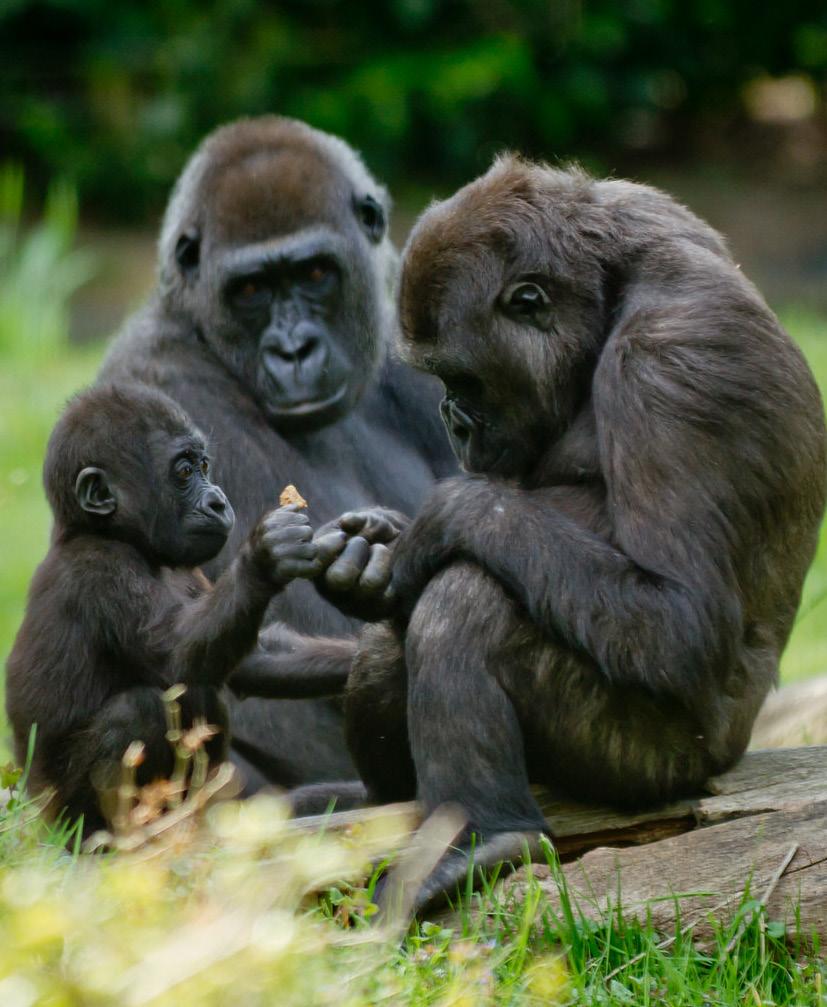
Four endangered mountain gorillas from Mgahinga National Park in Uganda were suspected to be electrocuted by lightning in early February. An international response team led by the Greater Virunga Transboundary Collaboration (GVTC) found ‘gross lesions’ upon post-mortem, however confirmation of the cause of death will be determined in two to three weeks after a histopathology laboratory exam. The deceased gorillas comprised of three adult females, one of whom was pregnant, and one male infant. The other 13 surviving members of the family, named the Hirwa group, were in general good health and are continuing to be monitored by GTVC and its partners. The preliminary cause of death was determined by post-mortem examination, field assessment observation and history. A Mgahinga Gorilla National Park tracker was reported by Gorilla Doctors to have heard the cries of surviving group members along with the sound of silverback gorillas beating their chest immediately after the lightning strike in the storm. It is likely that the electrical energy passed through the ground where it was struck directly by lightning and was absorbed by the four apes standing nearby.
The mountain gorilla moved from critically endangered to endangered Gemisha Cheemungtoo discusses the fatal freak accident 1000 the estimated population of mountain gorilla's worldwide
The mountain gorilla, one of two subspecies of the eastern gorilla, is estimated to have an overall population of 1000 in the world. Uganda’s Bwindi Impenetrable National Park is the habitat of one population of mountain gorillas. Mgahinga National Park, part of the Virunga massif spanning across Rwanda and the Democratic Republic of Congo, is home to the other population.
The three females' potential contribution to the population was immense
In 2018, the International Union for Conservation of Nature (IUCN) moved the mountain gorilla from ‘critically endangered’ to ‘endangered’ on its Red List of Threatened Species. However, the GVTC have called this incident a “big loss for the species”. Andrew Seguya, executive secretary of the GVTC, told the BBC: “The potential of the three females for their contribution to the popula- tion was immense.” The report by Gorilla Doctors also states: “This case, while extreme, also highlights the fragility of the endangered mountain gorilla population.” Although the loss of the four mountain gorillas through fatal electrocution was a highly unlikely event, the Democratic Republic of Congo, which the National Park encompasses, is a common location for lightning to strike. Five out of the world’s ten lightning hotspots are within the Democratic Republic of Congo, according to a study in the Bulletin of the American Meteorological Society.
13
the number of surviving members of the affected gorilla family


Solutions will be revealed in next week’s issue, available on campus from 2 March


35 You thought I was gone? I’m never gone. I will always be Puzzles Dictator and Fleetwood Town manager on the side. You clowns have no idea what you’d be like without me.
puzzles
1 2 3 4 5 6 MR TAYTO’S CROSSWORD The first person to find Editor-in-Chief Grace Dean with a completed copy of the crossword wins a mysterious prize from our puzzles drawer ACROSS DOWN
8 7
9 10 11 12
13
14 15 16
R 17
O 18
19 20
Y 21

1. County in West Ireland (8) 5. Sport played on horseback (4) 7. US State, capital Montgomery (7) 8. Multicoloured gemstone (4) 9. Fluid found inside trees (3) 10. First letter of the Greek alphabet (5) 13. A group of musical notes, as a basis of harmony (5) 14. 2016 Carly Rae Jepsen song (3) 15. Animal representing the star sign Aries (3) 17. English royal dynasty which held the throne from 1485 until 1603 (5) 19. Orginisation responsible for space travel and research (4) 20. Female sheep (3) 21. Biblical garden (4) 22. Mixture of oats, dried fruit and nuts that is often eaten for breakfast (6) 1. Type of large water lily (5) 2. Propety based boardgame (8) 3. Sloping typeface (6) 4. Australian marsupial (5) 6. South American
animal, similair to a camel (5) 11. Only landlocked South East Asian country (4) 12. Most abundant
chemical element in the universe (8) 13. Shoes associated with The Netherlands (5) 16. - in Chelsea , British reality TV series (4) 17. - for Fears, 80s pop duo who sang Everybody wants to rule the world (5) 18. German car
manafacturer (4)
#1403 SOLUTIONS C H I E F S A D V E N T H L U N E L L F G T C O W L D A N B R O W N R A R R A I S N P O D N A A S W A N S E A E G D N U M N F R I E N D S L A S I A E A A E I S D R O Y S T E R S B L A C K 6 1 3 8 2 4 5 7 9 9 8 4 3 5 7 6 1 2 2 5 7 6 1 9 8 3 4 8 3 2 5 9 6 1 4 7 1 4 5 2 7 8 3 9 6 7 9 6 4 3 1 2 8 5 4 2 9 1 8 5 7 6 3 3 7 8 9 6 2 4 5 1 5 6 1 7 4 3 9 2 8

SUDOKU 6 5 3 2 7 5 7 9 6 1 8 6 8 9 8
9 2 4 3 3 1 9 6 2
Barcelona baffle fans with bonkers Martin Braithwaite transfer Sport Editor Stanley Gilyead delves into Martin Braithwaite’s playing career to find out why Barcelona made him their emergency transfer replacement due to a bizarre La Liga rule after a spell of striker injuries
Little more than 12 months ago Martin Braithwaite started in Middlesbrough’s 1-0 loss to Burton Albion at the Riverside Stadium. Next week he could be playing in front of almost 100000 people at the Nou Camp in the famous blue and purple of Barcelona.
A quirk in La Liga’s transfer rules and a slice of luck have enabled Braithwaite’s rise
The transformation in Braithwaite’s fortunes comes after one of the most extraordinary chains of events in recent sporting history, as injuries to Suarez and Dembele, a quirk in La Liga’s transfer rules and a large slice of luck have conspired to enable Braithwaite’s meteoric rise.
The Danish international started out with Esbjerg fB in 2009. He scored 17 goals in 89 games for the club and helped them to a Danish Cup and Danish first division title before moving to French side Toulouse. He achieved moderate success with the club as he scored 35 goals over four seasons and helped them to a string of midtable finishes. From there he moved to Teeside, where he endured a disappointing few years, failing to nail down a first team spot and only scoring eight goals. Languishing as a Championship backup striker at the age of 27 Braithwaite must have felt that his opportunity to play for a major club had passed, but that started to change when he fell out with ‘Boro boss Tony Pulis and left the club.
After a couple of loan moves he departed for good last summer, joining La Liga side Leganés. Braithwaite enjoyed an upturn in form at the Madrid based side, he’s scored six goals and made two assists so far this season. Whilst the Dane has been praised for his performances he’s been nowhere near good enough to attract the interest of Barcelona under normal circumstances. The circumstance that led to his move, however, were far from normal.
Barcelona were dealt a blow earlier in the season as Luis Suarez was ruled out due to injury. Their situation worsened earlier this month as Ousmane Dembele suffered a serious hamstring tear. The French striker had to undergo surgery and was ruled out for six months, leaving Barcelona with only two fit forward players.
The severity of Dembele’s injury, however, meant Barcelona were handed a lifeline due to an unusual La Liga transfer rule not seen in any other major league. The law states that if a club has a shortage of players in a certain position, and are willing to deregister a player who has a long term injury, they are allowed to sign a player outside of a transfer window, as long as they are either a free agent or play for another La Liga club. Despite the fact that Barca’s two available strikers were Messi and Griezmann they qualified for the rule and were granted approval to sign a striker.
The law states clubs are only allowed to sign a player outside of the transfer window if they are a free agent or play for another La Liga club

Looking to spend as little as possible on the replacement Barcelona’s attention turned to Braithwaite and last week they had a bid of £15m accepted. Braithwaite, who is surely as surprised as the rest of us, jumped at the opportunity and signed a three and a half year deal with the Catalan club.
Whilst many see the story as a romantic one that gives all lower league players hope that their time may come, not everyone is The Nou Camp will be Braithwaite’s new home ground Image: Instagram @_campnou
Time to tackle ‘vicious circle of underinvestment’ All around Newcastle, the bars and pubs are teeming with people. With rugby fans, more specifically, drawn in by the six flags outside the doors; England, Wales, Ireland, Scotland, Italy and France.
The Six Nations is one of the biggest sporting events in the world, the average match is watched by 8 million people and the total prize fund this year is a not insignificant £16,000,000. The winner of the tournament will receive £5,000,000 with an extra million added on just for competing in the Grand Slam. Of course, these lucrative figures refer strictly to the men’s side of the competition. For the women, it is a very different story. There is no prize money.
In the midst of Storm Ciara, last weekend, Wales Women played Ireland, and lost the game 31-12. The second half was unfortunately overshadowed by torrential rain and powerful winds, as Ciara swept over the Energia Park in Donnybrook. In the post-match interviews, the players were visibly cold and soaked to their skin. The Welsh side were in no hurry to escape the rain and winds, however, by fleeing to their changing rooms, as it was cold showers that awaited them inside. Whilst Ireland Rugby has since apologised for the lack of hot water, the situation clearly demonstrates the often unfair treatment of women in rugby, and perhaps more broadly, the treatment of women in sport.
Of course, progress has been made in creating better opportunities for female athletes. In rugby, Australia have begun paying the same wage to their male and female players. World Rugby have rebranded the Rugby World Cup, removing ‘Men’s’ or ‘Women’s’ from the title. They call this, “the ultimate statement in equality”. In football, significant investment has been made into the women’s side of the game and into securing the future of the women’s game with the Wildcats programme, which offers free football coaching for girls aged 5-11 in a fun and girls-only environment. In addition, the WSL, the highest tier of English women’s football, has been made fully professional. Lewes FC are a pioneering club who have committed to total equality between their men’s and women’s team and so offer the same wage, regardless of gender. There are positive signs.
Nevertheless, there are still plenty of people who argue that we cannot ask for men and women to be paid equally whilst men’s sport often brings in so much more revenue than women’s sport. There are of course ex- ceptions to this. In 2015, the US women’s national football team earned $20,000,000 more in profit than the men’s team. However, perhaps worryingly, recent statistics show that women’s sports receive only 0.4% of to- tal sponsorships. Catherine Spence, 63 time capped England rugby player, suggests that this is a result of a “vicious circle of underin- vestment”. This point is also raised by WNBA player, Elena Delle Donne, who states, “we absolutely do not get promoted as our male counterparts do”, as a result, “a fanbase cannot be built”. The total prize fund for the men’s 6 Nations is £5m. For the women, there is no prize money Elana Shapiro investigates the funding differences between men’s and women’s professional sport
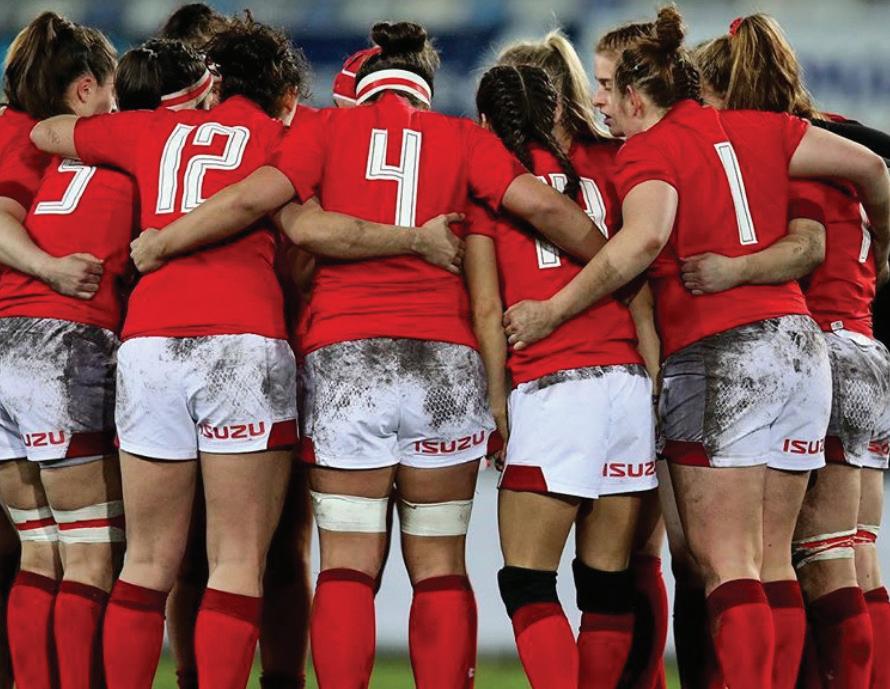
$20 million
The American women’s football team brought in this much more profit than their male counterparts last year
Coronavirus causes cancellations Rory Ewart reports on the virus’ impact in the sport world and for upcoming events
The Chinese GP has been cancelled Image: Flickr-emperornie

COVID-19, better known as the Coronavirus outbreak, has now infected over 70,000 people across not only Asia, but also the world as a whole.
Saturday 15th brought the inevitable news that it had taken its first victim in Europe, a Chinese tourist who’d visited France from the Hubei region of China.
These latest concerns now bring the reality of sporting events being cancelled or at least postponed for the foreseeable future. In total, so far, 18 different sports have seen events moved or wiped completely from their respective sporting calendars.
Included in the high-profile fatality’s are both the Chinese Formula One and Sanya Formula E Grand Prix’s, both being likely to have attracted thousands of supporters from Asia and further afield.
Multiple golfing LPGA events have also been completely cancelled in Thailand, Singapore and China, with European Tour competitions in China and Malaysia being postponed for the foreseeable future.
A huge blow to the Asian sporting calendar is the forced moving of the annual Hong
the courier 37 Monday 24 February 2020
sport Hat-trick super-star Shah Coronavirus causes cancellations
Sesha Subramanian profiles cricket’s latest rising star from Pakistan Barcelona baffle fans with bonkers Martin Braithwaite transfer delves into Martin Braithwaite’s playing career to find out why Barcelona made him their emergency transfer replacement due to a bizarre La Liga rule after a spell of striker injuries happy with the move. Leganés had little choice but to allow Braithwaite to move after his release clause was met and director general Martin Ortega has been vocal in his condemnation of the move. “We cannot understand the current regulation that a club, having a long-term injury, can perform this operation unilaterally and transfer their problem to our club,” he said. “We consider that there is a regulation that is unfair, from which Barcelona has benefited. The one who is damaged by this is Leganes”.
Whatever anyone’s view on the fairness of the regulation, what can’t be denied is that it has ended up providing us with one of the most unexpected stories of the season, as Braithwaite becomes quite possibly the first player to go from ‘Boro to Barca in little over a year. Braithwaite’s former club, Leganes, had little choice but to allow him to move after his release clause was met Former Team GB gold-medallist, Alex Danson-Bennett, has announced her retirement from hockey after suffering from long-term concussion.
The hockey star banged her head against a wall whilst on holiday and has since suffered long-term effects such as headaches, light sensitivity and speech loss.
Despite the Tokyo Olympics being around the corner, Danson-Bennett has described the risk of playing as “too high” with the challenge of returning to play after the head injury being “too much”.
The former captain has 306 caps to her name, with 116 goals under her belt after an 18-year playing career.
Danson-Bennett’s head injury raises more concerns about how head injuries are treated, both on and off the field of play. This comes as there has been a lot of changes to various sport recently about how head injuries are dealt with, both at a professional and amateur level. Rugby and football associations have also introduced new regulations to deal with concussion.
Cricket have recently introduced concussion substitutes. Over the summer when England played Australia at Lord’s, Steve Smith was bowled by Jofra Archer, a ball which hit him on the head. After receiving a concussion test and resuming play, Smith woke up the following morning suffering dizzy spells and was pulled from the rest of the test, with Marnus Labuschagne replacing him as a concussion substitute.
Whilst Labuschagne was used as the first concussion substitute in test cricket ever, it still begs the question of why Smith wasn’t watched closer for these signs. Smith is a stubborn player who will want to carry on no matter what, but his health must take priority.
As the issue of concussion continues to be a debate within sport, Danson-Bennett’s injury raises questions about how concussions are treated by sporting organisations outside of the playing field and how they look after their players. Recently there have been great change in sporting regulations about how concussions are treated reports on the virus’ impact in the sport world and for upcoming events Head of Sport Rebecca Johnson discusses the impact of concussion injuries on sports stars Alex DansonBennett retires

Kong Sevens rugby tournament, it typically takes place in April of each year, attracting thousands of rugby fans from across the globe to watch the shortened version of the classic 15-aside format of the game.
Why have so many events been cancelled you may wonder? Simply put, governments from around the world are trying to contain the transit of people from in and around Eastern Asia, especially from China and

more specifically the Wuhan region of the country, where the virus originates.
This has meant that sporting events have had little choice but to postpone events due to safety fears for fans. This mirrors the action taken by nations worldwide, who have postponed all travel to the Wuhan region unless essential. The UK Foreign and Commonwealth Of- fice have recommended “UK nationals to leave China where possible. If the situation continues to escalate the pressure on the Chinese health system may intensify, and it may also become harder for people to travel”. The outbreak of Coronavirus couldn’t have come at a worse time for organisers of the 2020 Olympics taking place in Tokyo, the first time the country has hosted the biggest sporting event in the world since 1964.
At present, the cancelling of the prestigious event, meant to play host to 33 different sports, “has not been considered” according to the 2020 Games chief Toshiro Muto. This, despite multiple qualification events being postponed already for the main games itself.
The NHS has advised that travellers arriving in the UK from countries including China, Japan and the Republic of Korea to stay alert to “symptoms of cough or fever”. If discovered, the person(s) should stay indoors, as if they have the flu, and inform NHS 111 of their recent travel from Eastern Asia. Sixteen year old Naseem Shah became the youngest player ever to take a test match hattrick when he dismissed the Bangladeshi trio of Najmul Hossain, Taijul Islam and Mahmudullah during the first test between Pakistan and Bangladesh at Rawalpindi.
He needed a review to get Najmul out legbefore-wicket before trapping Taijul LBW as well. On the hattrick delivery, Haris Sohail took a smart catch to get Mahmudullah out, with Shah becoming the youngest test hat trick-taker at the age of 16 years and 359 days. The previous record was held by another famous Pakistani cricketer Abdul Razzaq who achieved the record at 20 years of age against Sri Lanka in 2000.
Born in Lower Dir, Khyber Pakhtunwala, Shah is a right handed fast bowler who made his first class debut in September 2018 in the 2018-19 Quaid-e-Azam trophy.
Since then, his rise to the top has been nothing short of phenomenal. In October 2019, the Pakistan Cricket Board named him as one of the six players to watch out for ahead of their 2018-19 National T20 Cup.
Taimur Khan spotted Shah, he described the teenager as “exceptional”
clarified that the ages of all the players taking part had been verified and that given Shah’s calibre now as a full international, they felt he was better off not playing in the World Cup.
Taimur Khan, who spotted Shah at a camp in Peshawar told BBC Stumped presenter Alison Mitchell, “You know when he was with me in the national camp for the under 16’s, he was down to earth, quick learner and he was listening to all the senior players, always asking them for tips. He was very good in training, always on time and diet conscious at that age. That
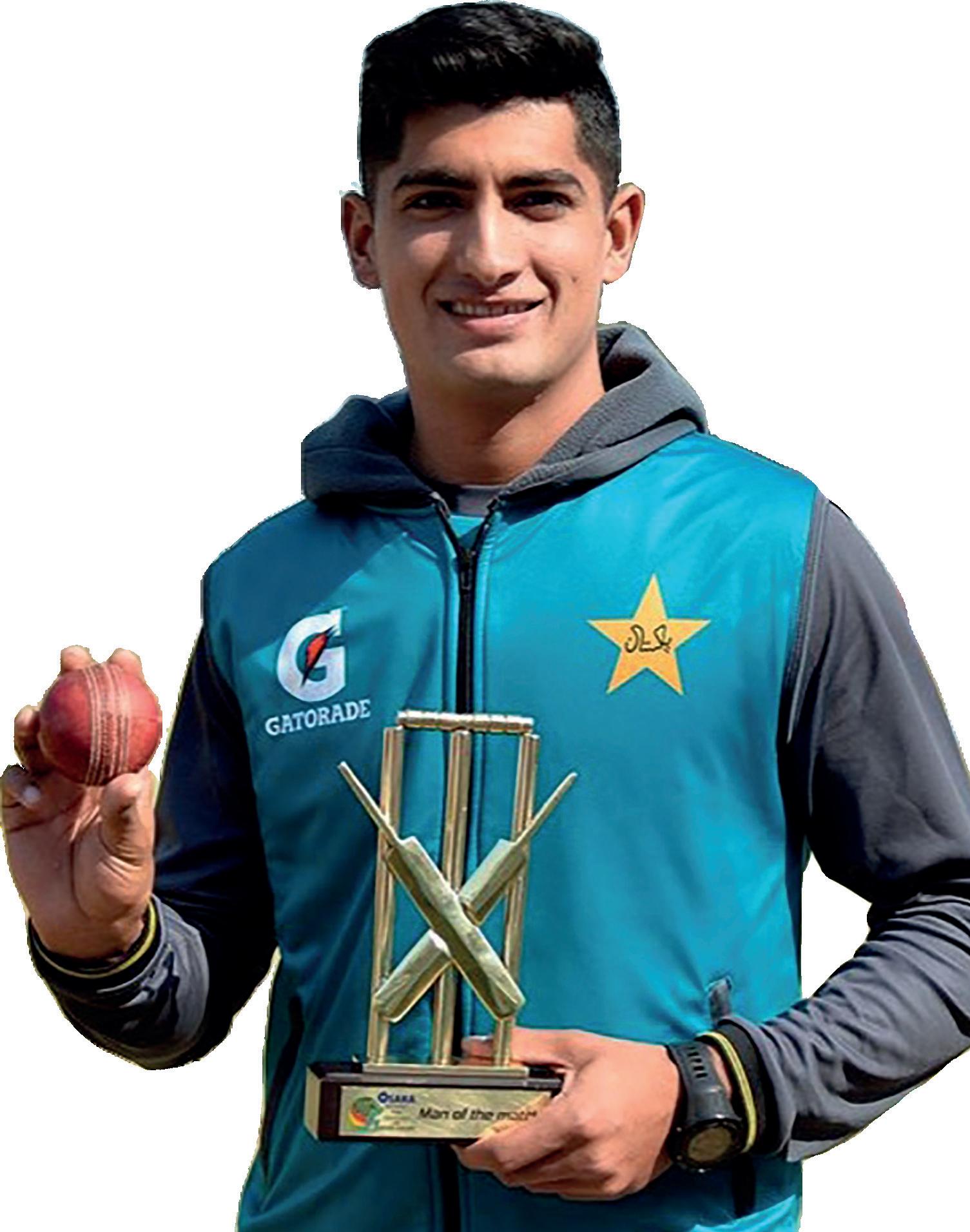
made him an exceptional case.”
Pakistan is not new to the trend of handing extremely young players an international debut. Hasan Raza for example, made his full international debut for the country in tests aged 14 years and 227 days against Zimbabwe.
There have been many others from the nation as well including Mushtaq Mohammad, Aaquib Javed (who won the 1992 World Cup with Pakistan) and Aftab Baloch.
While it remains to be seen if Shah’s early international start and success can translate into a long and fruitful career, the teenager looks like one of the best youngsters in the game.
He made his full international debut against World Cup semi-finalists Australia in November 2019. It didn’t take long for him to make an impact as in the next test series against Sri Lanka, he took five wickets in the second innings of the final test to give Pakistan their first home test series win since 2006. He is also the second youngest crick- eter to get a test 5-for.
He was supposed to be part of the ICC under-19 World Cup team for Pakistan this year but the PCB withdrew him for “cricketing reasons”.
There were some doubts about whether they were lying about his age but the board Naseem Shah with his match ball and man of the match award Image: Instagram @therealpcb
Calamitous coppers cause bother down in Barnsley ing for horse charities). It should, of course, come as little surprise that papers are keen to report on something that provides shock value. There is a perception that the press is in service of a higher purpose – namely the public’s education, information and intellectual enrichment – and while it is able of fulfilling this purpose, it is still comprised of private corporations. It comes as little surprise that the papers are keen to report on something that provides shock Joe Molander ponders on the under-investigation incident which took place at Barnsley’s home clash with Sheffield Wednesday
The Hillsborough Disaster is a focus point over police tensions in football Image: Wikimedia
A 16 year-old boy suffered a head injury following police clashes after Barnsley played Sheffield Wednesday at home.
The 1-1 draw inspired the ire of fans and authorities alike: in dramatic footage that has surfaced on social media, two fans are seen scrapping outside Barnsley bus station after the game. Then, a police officer runs into frame and slams his baton into one of their heads.
Someone who claims to have been there said on Facebook that the policeman “must have run 50 yards and had time to think about the situation. He could have quite easily hit him below the head, that was calculated [sic], he knew exactly what he was doing. I insisted to another copper that i [sic] wanted to report an assault and got told to go away”. Meanwhile, the Temporary Chief Superintendent for Barnsley and ‘Match Commander’ Sarah Poolman said that “our officers responded to disorder outside the
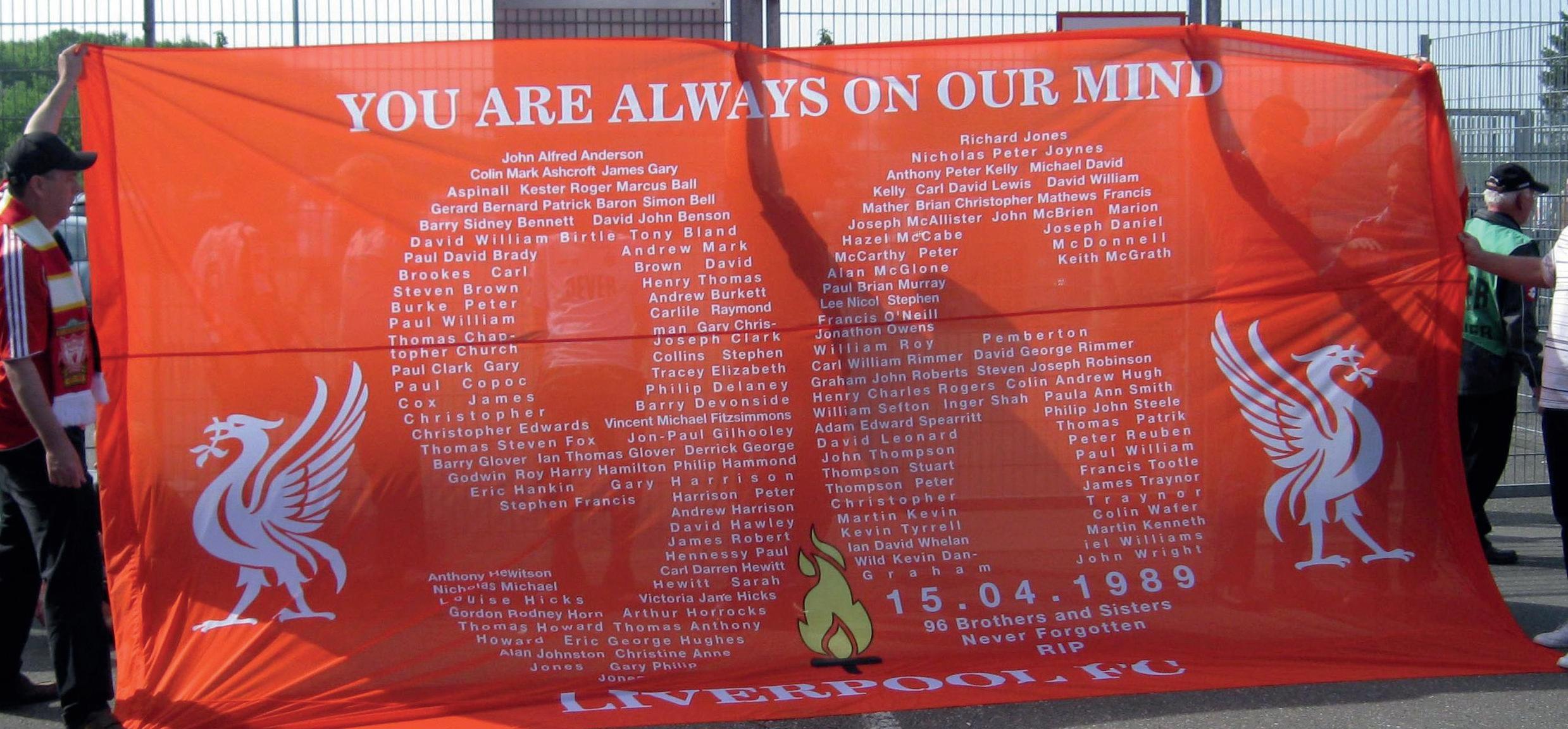
transport interchange. A full, open investigation, including extended video footage, will take place to ascertain the circumstances surrounding the incident, including the actions which led to a 16-year-old boy sustaining a head injury from an officer’s baton, and an officer being assaulted, sustaining injuries to his stomach and head. The 16-year-old boy was taken to hospital by ambulance. The police officer also attended hospital. Both of their injuries are not life-threatening”. The incident makes for an interesting point about the discourse surrounding football violence. The term ‘football hooliganism’ is usually used interchangeably, creating the idea that it’s the fans who initiate and are responsible for aggression. Everyone’s familiar with the Chelsea Headhunters, the fabled ‘English disease’ abroad, and – closer to home – the 2013 horse-punching episode in Newcastle (the next Newcastle-Sunderland derby, Sunderland fans lined up collectLike almost all private corporations, media outlets are looking to maximise profits or revenue, which means they release content designed to get clicks or to shift papers. More surprising, then, is why they don’t report on another similar issue. Something that receives far less coverage is violence started or exacerbated by the police. The Hillsborough Disaster remains such a sensitive issue in part because of the police involvement in the ninety six deaths. They were seen to be caused in part by a large influx of fans into the stadium caused by the police decision to open a large exit gate, for example. Worse was the cover-up that came later to shield the police from blame. The relationship of fans and authorities can be testy at the best of times
This is the latest incident that points to the police as an aggravating or destabilising force in dealing with rowdy fans. The relationship between fans and authorities can be testy at the best of times: it seems a poor operational move to make things worse unnecessarily.
Caving Club rock up to Sunset Hole
Newcastle University’s Caving Club report on their explorations and abseiling at Sunset Hole, an active cave located in the wet Yorkshire Dales
We decided that given the wet conditions in the Dales, we would tackle Sunset Hole, an active cave that is passable in all but the worst conditions. Our small group, consisting of Jen, Yasmin, Joe, Jacob and I set off from a layby in Chapel Le Dale, and we reached the cave entrance on the flanks of Ingleborough after about 30 minutes walking.
Heading down, the first few 100ms of the cave were pleasant walking passages, until we reached the first obstacles, a short abseil down a waterfall, followed by a traverse and another abseil. In the pool at the bottom of the second abseil, I stripped off my SRT kit, and the team continued. David Keegan at Sunset Hole
Jen and Yasmin decided to take some time to admire the majestic waterfall and set themselves up in the emergency shelter
Shortly after, we split off, with most of the group continuing down the main passage, leading to an 18m abseil into the main chamber, while I attempted the bypass. What followed was a short awkward crawl through a bedding plain, before I reached the squeeze; climbing up to the top of a rift I was then able to wriggle my way through an extremely tight, 4m long squeeze, before dropping back down on the other side. Continuing through the rift passage, I then found myself on a ledge 4m above the main chamber.
The first few 100m of the cave were pleasant walking passages, but then we had to abseil down a waterfall
Once the rest of the group had got to the main chamber, they were able to pass a ladder up, which I rigged to enable them to follow. At this stage, Jen and Yasmin decided to take some time to chill and admire the majestic waterfall in the final chamber, and set themselves up in the emergency shelter. Meanwhile Jacob, Joe and I continued into the extension series, a section of low fossil passage, before abseiling down another short drop and heading through the corkscrew, a tight twisting squeeze leading to an eerily si- lent final chamber. Having reached the end of the cave, we headed back out, with everyone going via the main route, and heading back to the Bradford Pothole Club for Dinner and rest.

For fans’ sake... let the storm win For Jamie Armstrong there must be change in how football handles extreme weather days in light of Storm Ciara
BUCS RESULTS
Wisbech’s ground was destroyed by the storm Image: @wisbechtown fc (Twitter)

As VAR, vast transfer fees and overt commercialisation suck the soul and tradition out of football, games played in horrendous conditions on slide-tackle conducive pitches, seemingly offer a lifeline to the days before players wore gloves and dived. The good old days some might say. Regardless of the romanticism of muddied warriors clattering into tackles...
However, the football authorities’ handling of Storm Ciara’s impact on the footballing calendar questions their regard of fans, players and quality of football.
Giving fixtures as much time as possible before deciding whether to cancel them might make sense to some, but these decisions negatively impact fans and potentially players. Warnings from the police and the Environment Agency forecasted 80 mph winds over the weekend. This should have led to the FA and WSL enforcing blanket postponements for all fixtures to avoid any potential danger for travelling fans and teams.
Ash Head, owner of Isthmian League side Lewes FC requested a blanket postponement but claims to have been ignored. The lack of advice from relevant associations led to clubs and fans travelling around the country for matches that were then postponed. This then caused fans and teams to make potentially dangerous return journeys as Storm Ciara caused nationwide disruptions.
80mph
The maximum speed projected for Storm Ciara
Head told the Telegraph, “Villa travelled at least part way to Durham and Sheffield were headed to London to play Charlton. Those teams now need to get home in dangerous conditions. A flag from the FA on Saturday morning could have saved a lot of wasted time and potentially unrecoverable costs.”
The fact that only the Women’s National League issued advice to clubs on Saturday, warning teams and fans not to travel represents the disregard modern football has for fans. The juggernaut nature of modern football, seemingly means that the show must go on regardless of whether it is dangerous or financially detrimental for fans.
Had games gone ahead during Storm Ciara the quality would have suffered. Regardless of the romanticism of muddied warriors clattering into tackles or wind-swept goalkeepers rolling around in swamp-like six-yard boxes, football should have evolved past this.
Holding out for games in such conditions not only shows contempt for fans whose safety is compromised, but also for players who wouldn’t reap the physical benefits of a winter break after playing in a storm.
However, given the unstoppable force of modern football, it can only be forecast that those in power will keep trying to force fixtures to happen regardless of the weather, or fans…or players.
Women’s T20 World Cup underway Down Under
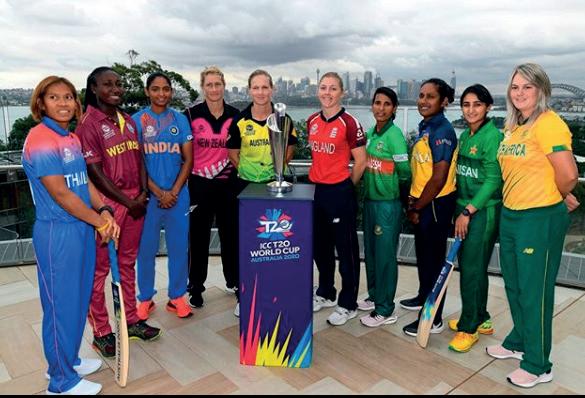
The Women’s T20 World Cup got underway on Friday, with India taking a surprise win over hosts and tournament favourites, Australia.
This is the seventh World Cup played since the tournament was founded in 2009, and been run biannually since 2010. Australia have won four World Cups, with England having won the first one in 2009 and the West Indies winning one in 2018.
After winning in the West Indies in 2018, Australia are on hosting duties with the tournament lasting seventeen days, with the final being played at the Melbourne Cricket Ground (MCG) on International Women’s Day. Ten teams will be playing over the next couple of weeks, countries that include England, New Zealand, Sri Lanka. Thailand also made their tournament debut against the West Indies last Saturday.
Australia are the tournament favourites, with a good track record and arguably the best team in the world. Their side is jampacked with big names in Aussie cricket such as captain Meg Lanning, wicket-keeper and batswoman, Alyssa Healy and, of course, the best all-rounder in the game, Ellyse Perry, who recently won the prestigious Belinda Carlisle award at the Cricket Australia awards.
However, despite this all-star line-up, the Aussies had a dreadful start in their efforts to retain the World Cup. India won by 17 runs to kick-start their campaign to win their first ever World Cup. Efforts from Alyssa Healy, who contributed 51 runs to the Australian score were no match for India. An unbeaten 49 from batswoman Deepti Sharma set India up for a solid 132-4. Poonam Yadav, got 4-19 as the Australians struggled to get off the mark and failed to reach the target, falling for 115 all out.
A shock Australian defeat will be reassur- ing to the rest of the competitors, proving that the top-ranked side in the world are only human and are capable of being defeated. England will be hoping to make a serious impact on the tournament, after winning the 50 over World Cup in 2017, and to showcase some of the talent within the squad. They go into the World Cup under new coach, Lisa Keightley, who will be aiming to see her side progress well to the later stages of the tournament.
England are a side who have a lot of talent. Captain Heather Knight excelled in Australia’s Big Bash tournament over the winter, scoring 282 runs for the Hobart Hurricanes. Furthermore, left-arm spinner Sophie Ecclestone has burst onto the scene and cemented herself firmly in England’s bowling line-up after taking a series of wickets in the tri-series against India and Australia and producing consistent results.
Whatever the outcome, this edition of the World Cup promises to be a good one. With hosts Australia fazed at the first hurdle, other teams will be sure to pounce on their mo- ment of weakness. Sides like India and the West Indies shouldn’t be dismissed as serious challengers, and a strong New Zealand side will be sure to try and quietly sneak their way to the final. Further still, it will be interesting to see how debutants Thailand fare at the tournament and whether they can successfully hold their ground against some of the biggest teams in women’s cricket. Hopefully England can capitalise on their recent good form, and with a new coach, try out some new tactics to win the tournament. Rebecca Johnson assesses each team’s chances in the seventh instalment of the T20 World Cup Australia are tournament favourites, arguably being the best team in the world
How many T20 World Cups Australia have won since the tournament was established in 2009 4
Australia are favourites for the tournament
Image: Instagram @ t20worldcup
VOLLEYBALL M1 v Cambridge 1sts 6-0 M2 v Leeds Beckett 6ths 1-5 W2 v Sheffield 1sts 1-5 TENNIS W1 v Bristol 1sts 2-6 W2 v Nottingham 2nds 0-8 BADMINTON M1 v Bournemouth 1sts 83-70 M2 v Durham 2nds 71-60 M3 v York St John 1sts 74-75 W1 v East London 73-86 W2 v Durham 2nds 27-67 BASKETBALL M1 v Leeds 1sts 125-130 FENCING
M2 v Sheffield 2nds 1-0 M3 v York 1sts 0-4 M4 v Hull 2nds 11-0 W3 v Leeds Beckett 2nds 1-1 W4 v Leeds Beckett 3rds 2-0 HOCKEY M1 Sheffield Hallam 1sts W/O Ncl M2 v Leeds 2nds 5-1 W1 v Leeds 2nds 5-1 W2 v Sheffield 1sts 13-9 LACROSSE NETBALL 1sts v Northumbria 1sts 44-66 2nds v Durham 2nds 41-39 3rds v Sheffield Hallam 2nds 39-40 4ths v Leeds Beckett 4ths 33-38 1sts v Bath 1sts 78-4 2nds v York St John 1sts 41-6 RUGBY LEAGUE M1 v Oxford 1sts 0-5 M2 v Sheffield 1sts 0-5 M3 v Leeds 2nds 0-3 W1 v Bristol 1sts 5-0 W2 Leeds 2nds 1-4 SQUASH M2 v Northumbria 2nds 0-3 M3 v Hull 3rds 3-3 W1 v York 1sts 1-2 W2 v York 2nds 2-1 FOOTBALL TABLE TENNIS M1 v UCL 1sts 6-10 M2 v Sheffield Hallam 1sts 10-7 M3 v Liverpool 3rds 16-1 W1 v York 2nds Walkover Ncl M1 v Imperial 1sts 3-0 W1 v Coventry 1sts 3-1 M1 v Notthingham 1sts 10-17 M4 v Leeds 2nds 10-22 M5 v Hull 2nds 0-52 W1 v Bristol 1sts 78-4 W2 v York St John 1sts 41-6 1sts v St Andrews 1sts 2.5 v 3.5 2nds v Leeds 1sts 2.5 v 3.5 GOLF RUGBY
ULTIMATE M2 v Northumbria 1sts 3-15 WATERPOLO
M2 v Sheffield Hallam 2nds 4-13

ROY KEANE’S QUOTE CORNER Despite Manchester United not doing well at the moment, I haven’t headbutted anyone recently, which is pretty decent for me. Anyway, here’s your quote: “I only ever hit Roy (Keane) the once, he got up so I couldn’t have hit him very hard”- Brian Clough
sport the courier
Monday 24 February 2020 Issue 1403 Free @Courier_Sport courier.sport@ncl.ac.uk thecourieronline.co.uk/sport Head of Sport Rebecca Johnson Sport Editors Rory Ewart, Stan Gilyead, Toby Bryant & Tom Moorcroft
Busy BUCS Championships for PB-happy NUAXC Newcastle University Athletics and Cross-Country President Shona Haston reports on their recent indoor competition
The team all smiles after a weekend of running Image: NUAXC
BUCS Nationals sees the top university athletes from across the country brought together for a weekend of tough competition in Sheffield. Incorporated was the Indoor Athletics Championships at the English Institute of Sport, the highlight of the indoor season for NUAXC.
There was disappointment for crosscountry as the arrival of Storm Dennis caused yet another race to be cancelled with a waterlogged car park, but luckily there was no fields in sight for the athletics squad, just a nice tarmac car park and indoor track.
The team travelled down on Friday 14th February, ready for the sprinters to kick off the first of three days of athletics. The 18-strong team provided great support for everyone, along with the rest of NUAXC watching on the live stream back in Newcastle. Shona Haston at English Institute of Sport, Sheffield Day 1
Inside Sport today >>> Coronavirus Rory Ewart looks at the virus’ impacts on the sporting world Page 36-37 All of the recent block practice clearly paid off, with strong starts for Sophie Thorpe, Alice Nottingham, Daniel McCoy and Becci Ousby in the 60m and 60m hurdles races. A standout performance for Will Seed in his 60m hurdles heat saw him progress through to the final later that day. Liam Reveley also ran an impressive race, narrowly missing out on joining Will in the final by just 0.01 seconds. The hurdles final came with some added drama as a false start wasn’t heard until the end of the race, meaning it had to be re-run straight after. Even so, Will managed to break the club record, finishing 6th in 8.56 seconds.
1:46:42
Strickland, Nottingham, Ousby and Malpass’ recordbreaking time
The first day also saw the 800m heats for Bradley Wilsher, Maddy Squires and Shona Haston, with all three running strong races. Bradley managed a sprint finish to edge into 5th in his heat, Maddy ran a PB in her heat and Shona won hers, gaining automatic qualification through to the semi-finals, in what was a very tactical race. A long first day at the track was rounded off well in the field events, with Becci throwing 8.86 metres in the shot put and Harrison Whitfield comfortably qualifying for Sunday’s triple jump final. Day 2
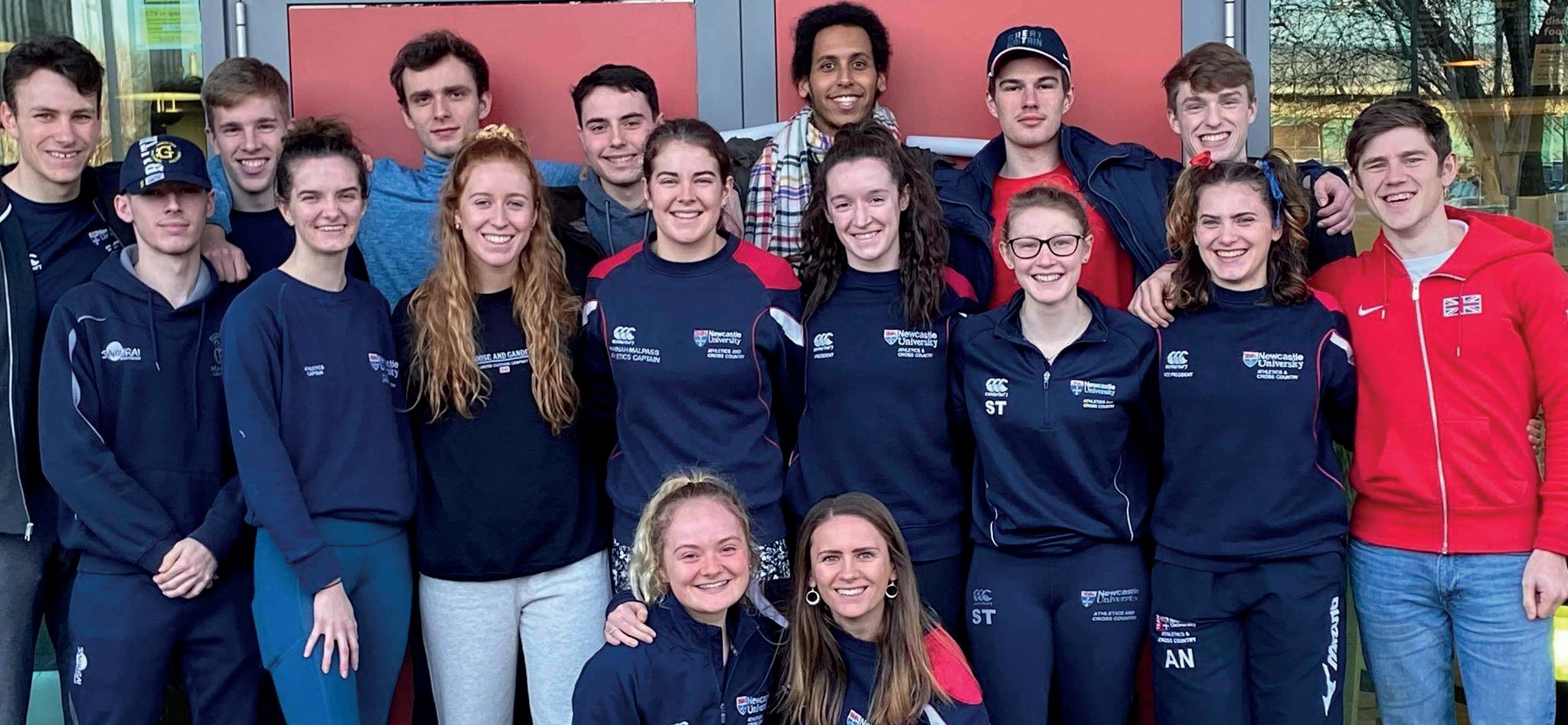
The team were up early again on the Sat- urday morning to get to the stadium for the 1500m heats. Jack Douglas held his own against a strong field, crossing the line in 4:19 for 5th in his race. Jeanclaude Doukrou, Will Seed, Emily Strickland and Han- nah Malpass were racing the 400m next. All four ran strong races, with Jeanclaude getting a PB, Will qualifying for the semi-finals and both Emily and Hannah finising 3rd in their respective heats. Shona’s 800m semifinal was the faster of the two, pushing her on to run a 3 second PB in 2:14.59, break- ing her own club record and putting her 8th fastest overall.
Following was the highly anticipated mas- cot race, unfortunately without Newcastle’s mascot however, which had been left back up North.
It would be a tough act to follow, but Liam Reveley managed, qualifying for the high jump final in just one jump. The long jump saw some inter-club rivalry between Luke Whittington and Sam Pooley, with Luke just getting the edge over Sam by 0.02 metres.
The final event of the day was the 4x200m relay heats. The men’s team (after a lot of deliberation) consisted of Will Seed, Dan- iel McCoy, Sam Pooley and Liam Reveley. They finished 4th in their heat in a time of 1:35.59, with Liam running comfortably under 23 seconds to claim the fastest leg time.
The women’s 4x200m team of Emily Strickland, Alice Nottingham, Becci Ousby and Hannah Malpass ran a club record breaking time in 1:46.42 to finish 2nd in their heat, with both Hannah and Emily running sub-26 second splits.
A couple of ice baths and a good night’s sleep later, and the team were ready to take on the final day of the competition, which kicked off with the 200m heats. Ryan Stacey made a brief appearance in Sheffield to race, along with Sophie and Alice.
All three ran seasons best times, unfortunately resulting in a quick lactic-induced chunder for Sophie. Next up was Will (who had already ran five races over the course of the previous two days) in the 400m semifinals. He still managed to produce another Day 3
good run, finishing in 50.38 seconds.
The rest of the day consisted of watching the many track and field finals which saw top athletes such as GB pole vaulter Holly Bradshaw competing. The finals also included NUAXC’s own Harrison in the triple jump and Liam in the high jump. Harrison finished 8th overall with a best jump of 13.71 metres. It was bittersweet for Liam, who finished 4th with 1.99 metres, just missing out on getting a coveted BUCS medal.
A special thank you must go to the athlet
ics captains, Emily Davis and Emily Strickland, for organising and supporting over the weekend, despite Davis being too injured to compete herself. The indoor season might be over for NUAXC, but there’s still plenty of competitions to be working hard for, with the outdoor season starting soon, and efforts focusing towards BUCS Outdoors in May. A couple of ice baths later and the team were ready to take on the finals
Elena Shapiro discusses the differences in prize money for men’s and women’s sport Page 36 Gender pay-gap

